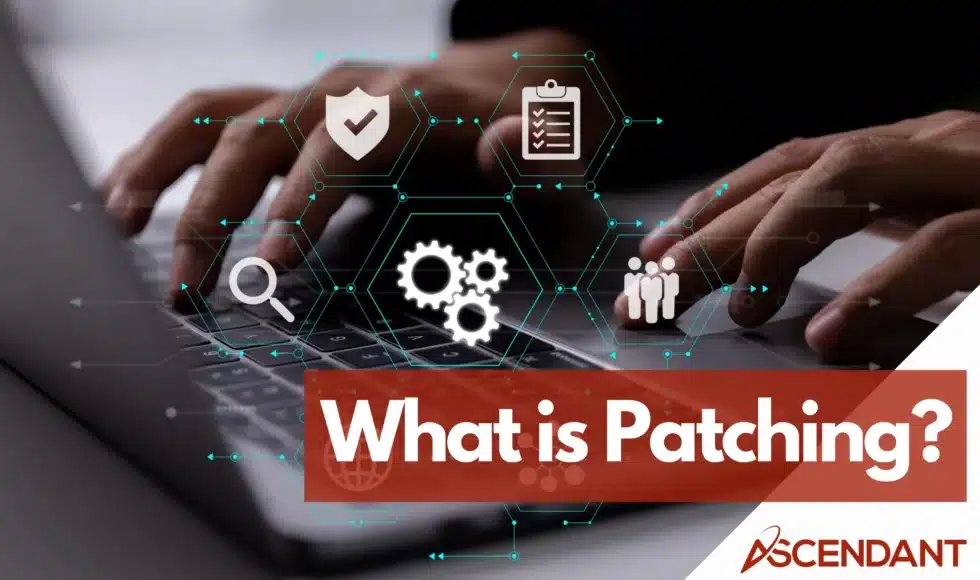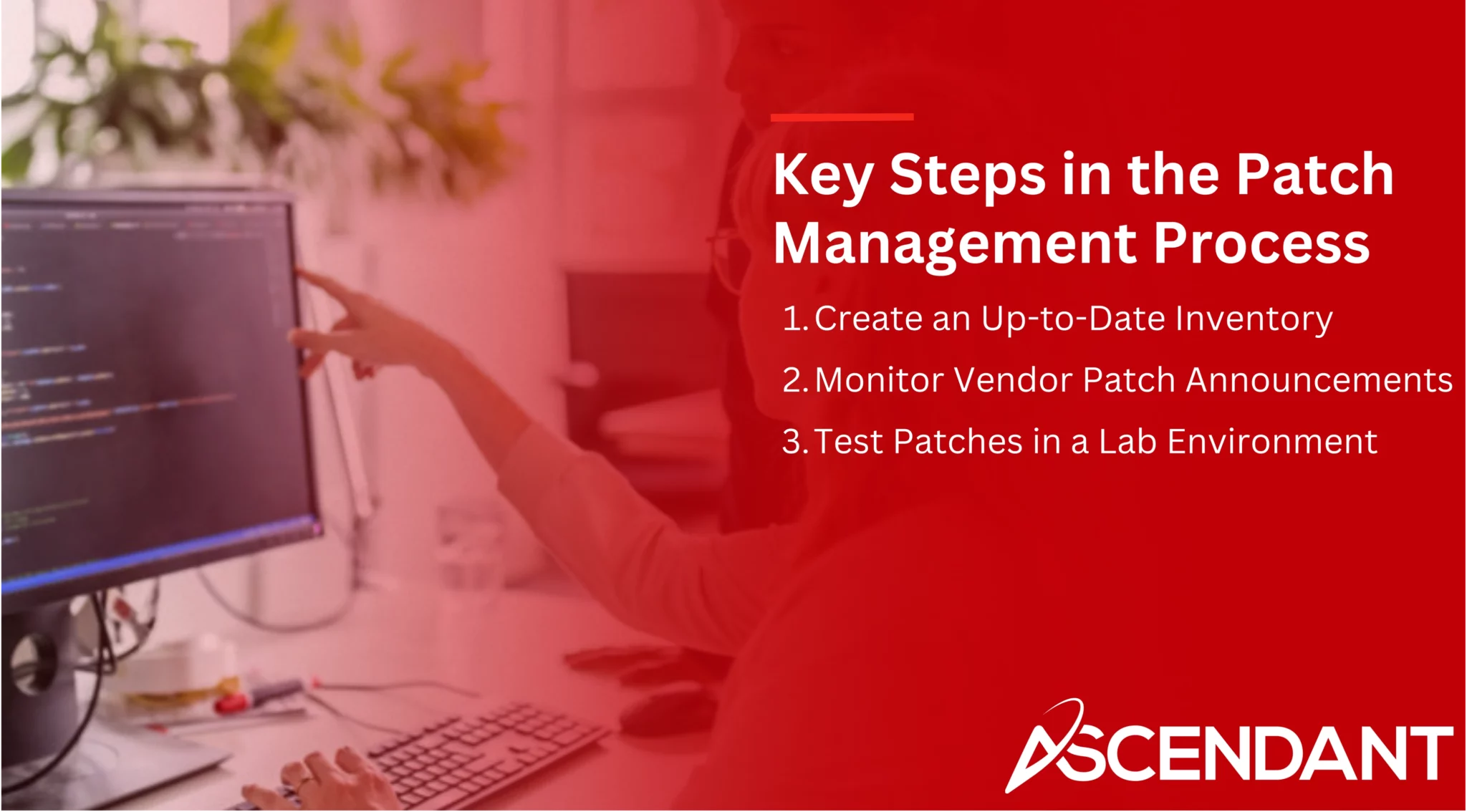Patching is vital for keeping your IT systems secure by fixing vulnerabilities and preventing breaches. This article delves into the best practices for effective patch management to protect your organization from potential cyber threats.
Key Takeaways
- Patching is essential for IT security, fixing vulnerabilities and improving software functionality through regular updates.
- Effective patch management involves systematic processes such as vulnerability identification, testing, and timely deployment to reduce security risks.
- Collaboration with managed services providers can enhance patch management by ensuring timely updates and maintaining compliance with industry standards.
Understanding Patching
Patch management is an essential aspect of sustaining both the security and efficiency of your IT infrastructure. Essentially, a patch modifies existing software, configurations, or files with the aim to correct errors and close security gaps. By incorporating these patches into your systems, you not only fix current issues, but may also gain access to new features that enhance how the software performs. The consistent application of patches serves as a shield against potential threats by preventing malicious exploitation.
The process of managing these updates extends across all types of system components. It involves keeping up-to-date on firmware and drivers. To software modifications which are integral for fortifying defenses against exploitable flaws. Through this meticulous approach—spotting vulnerabilities, meticulously testing out proposed fixes prior to full deployment—you ensure that operating systems, various applications, as well as network devices (including those dedicated solely to patch administration), operate securely and effectively.
Grasping the intricacies involved in overseeing a comprehensive patching cycle offers significant reinforcement towards safeguarding your organization’s digital barriers from cyber breaches.
The Importance of Patch Management
The importance of effective patch management in safeguarding IT systems cannot be overstated. Swiftly addressing potential weak points is crucial in diminishing the likelihood of security infringements. By implementing regular patch updates, organizations can bolster their defenses and maintain consistent operational performance, which is essential for ongoing business processes. Compliance with regulatory frameworks like GDPR, HIPAA, and PCI DSS often hinges on keeping up with these updates.
A well-executed patch management process supports an organization’s integrity by preventing costly breaches that could otherwise tarnish its reputation. The expedient deployment of patches serves as a deterrent against threats to cybersecurity and ensures the protection of confidential information. Formulating a clear-cut strategy for managing patches reduces exposure to threats while simultaneously advancing overall system safety.
Enlisting the aid of managed services providers can amplify effectiveness when it comes to administering patches properly. These external partners excel at tracking announcements from vendors regarding new patches and guarantee that vital upgrades are applied without delay—this cooperation not only refines the efficiency associated with managing these fixes, but also helps ensure adherence to various compliance mandates set forth by industry regulations.
Key Steps in the Patch Management Process
The patch management process encompasses several essential actions designed to facilitate the effective deployment of patches. The process includes these steps:
- Detection of system vulnerabilities within your IT landscape, which allows for prioritizing critical patches.
- Evaluation of test patches in a secure setting to confirm their proper operation and that they do not lead to additional vulnerabilities.
- Systematic application of patches, ensuring they are executed on schedule while preserving the integrity of systems.
Incorporating leaders into the creation of patch management policies can improve cooperation throughout an organization. A collective strategy ensures prompt attention is given to important updates, especially those concerning operating systems, thereby minimizing system susceptibilities.
It is vital to observe systems after deploying a patch vigilantly. This helps guarantee that new software introductions don’t interfere with existing configurations and any emerging concerns are swiftly resolved.
Create an Up-to-Date Inventory
To establish an effective patch management strategy, it is essential to first compile and continually update a comprehensive list of all the hardware and software within your organization. This inventory must encompass each piece of firmware from hardware suppliers as well as every application and operating system in use, addressing any potential vulnerabilities. Utilizing automation tools can significantly enhance the efficiency of managing this inventory by keeping precise tabs on all assets.
Prioritizing patches according to the associated risk levels with different systems is also crucial for a robust patch management process. By sorting assets into categories based upon their risks, you’re able to identify which patches require immediate attention. The creation of a detailed catalogue of production systems enables consistent implementation and monitoring of updates throughout your company infrastructure, guaranteeing that no critical system gets neglected when distributing updates.
Monitor Vendor Patch Announcements
Keeping abreast of announcements from software vendors regarding patches is crucial for effective patch management. Typically, these patches are announced via email notifications, and companies specializing in patch management software keep databases that monitor these updates. By keeping an eye on such vendor communications, organizations can swiftly administer necessary fixes to preserve the security of their systems.
Collaboration with a managed services provider may bolster the handling of vendor patch alerts. These providers assist in guaranteeing the expedient deployment of patches, mitigating the danger associated with overlooking essential updates. This proactive strategy constitutes a fundamental component of best practices in patch management, ensuring swift and competent application of all available patches.
Test Patches in a Lab Environment
The patch management process necessitates evaluating patches within a laboratory setting before integrating them into live production systems. In this isolated environment, IT departments can validate the appropriateness of each patch and uncover any problems in advance. Correcting compatibility concerns during these preliminary tests enables organizations to avoid disturbances in their operational systems.
Employing a systematic testing regimen that includes establishing a baseline allows for thorough examination while also dealing with urgent security flaws promptly. Such strategies are critical to ensure patches function as intended without causing unforeseen issues once released into the actual production landscape.
Comprehensive pre-deployment testing is instrumental for achieving an effective patch management procedure, significantly reducing the risks associated with implementing patches and safeguarding the integrity of production environments from vulnerabilities.
Best Practices for Effective Patch Deployment
Deploying patches effectively requires following best practices to ensure system security and functionality. Automation, prioritization, and scheduling are key components of an efficient patch management process. Automating patch deployments reduces human error and speeds up the process, ensuring patches are applied quickly. Prioritizing critical patches based on their risk levels helps mitigate security risks and address vulnerabilities promptly. Scheduling regular patch updates maintains ongoing security and system reliability.
Collaboration with managed service providers can further streamline the patch management process. These providers offer remote management capabilities and expertise, enhancing the efficiency of patch deployments. Documenting new patch applications and backing up the production environment before applying patches are also essential best practices.
By following these best practices, organizations can ensure effective patch management and minimize operational disruptions.
Automate Patch Deployments
The process of patch management is transformed significantly by the introduction of automation in deploying patches. The utilization of automated tools makes the deployment phase more efficient, cutting down on both the effort and time traditionally involved in manually monitoring and rolling out patches. This acceleration not only expedites the entire patching procedure, but also reduces susceptibility to human mistakes.
Incorporating automation into their systems enables organizations to execute patch applications with greater speed and precision, thereby bolstering their cybersecurity defenses. It frees up IT personnel to dedicate attention to higher-level initiatives while confidently maintaining a seamless operation within the background processes of patch management.
Prioritize Critical Patches
Effective patch management necessitates prioritizing crucial patches, and utilizing a ranking framework such as CVSS is instrumental in evaluating the significance and immediacy of each patch. Concentrating on security-related patches that rectify grave vulnerabilities allows organizations to reduce potential pathways for attacks and diminish risk.
It’s vital for organizations to implement a regular review mechanism to evaluate and recalibrate the priorities of patches in alignment with changing security environments. This forward-looking strategy guarantees swift attention to new vulnerabilities, upholding the robustness of your IT system’s defenses. Efficiently prioritizing these updates is key in averting data breaches and safeguarding confidential data.
Schedule Regular Patch Updates
Regularly scheduled patch updates are an essential component of robust IT security protocols. Establishing a routine for these updates enhances system stability and diminishes the likelihood of encountering security vulnerabilities, thus preserving consistent system functionality. The regular introduction of patches is crucial to securing seamless and proficient software performance.
To optimize patch management, it’s recommended that organizations implement their updates during times with reduced activity to curtail operational disturbances. Maintaining consistency in the timing of patch releases helps keep organizational systems both safe from potential threats and running at peak efficiency.
Embracing a forward-thinking strategy in managing patches is key to upholding the integrity of your organization’s IT infrastructure. This proactive stance not only bolsters defense mechanisms against cyber risks, but also reinforces overall technological resilience.
Handling Patch Exceptions
Sometimes, applying a patch may be infeasible or inadvisable due to compatibility or dependency issues. Organizations should anticipate these situations and have a plan for handling patch exceptions. Documenting the reasons for patch exceptions is essential for managing alternative solutions or workarounds.
When a patch cannot be applied immediately, it is crucial to mitigate the security risk by protecting the unpatched item. Limiting user access and protecting the system from internet exposure can help reduce the risk of exploitation.
By addressing patch exceptions proactively, organizations can maintain security even when immediate patch application is not possible.
Post-Patch Deployment Actions
After deploying a patch, it’s essential to keep an eye on the systems to detect and rectify any new problems that might emerge. Continually reevaluating the system once patches have been installed is crucial for verifying the success of these updates and confirming that they haven’t introduced any new vulnerabilities.
Keeping detailed records of all modifications made throughout the patch management process is indispensable in creating a transparent history for later review and audit purposes. Persistent assessment paired with meticulous documentation play key roles in upholding the integrity of your systems and equipping them for upcoming audits. These steps following deployment guarantee that your approach to patch management remains comprehensive and efficient.
Addressing Third-Party Applications
Managing patches for third-party applications is essential for maintaining IT security, as these programs frequently contain vulnerabilities that could be exploited. To avert possible security incidents, it’s important to stay vigilant about applying updates and patches to this software in order to curb risks while also boosting its performance.
To manage patching effectively requires coordinated effort across various departments and geographic regions, ensuring that every piece of software remains current. By adopting such an inclusive strategy towards patch management, you can avoid compatibility issues or system failures while safeguarding the integrity of your IT infrastructure against potential threats.
Integrating Patch Management with Vulnerability Management
Combining patch management within the broader scope of vulnerability management is crucial for a comprehensive IT security strategy. An effective patch management process significantly diminishes security threats by systematically tackling vulnerabilities found in software and applications. A methodical approach to this strategy prioritizes assessing and targeting vulnerabilities rather than haphazardly implementing fixes.
Such an integration promotes not only swift rectification of weaknesses but also upholds the operational integrity and protection of your IT systems. Gauging how well a vulnerability management program performs serves as both justification for financial outlay in such programs and ensures that they are tailored to meet organizational requirements.
Melding these two practices fosters a strengthened defense mechanism against potential breaches, enhancing overall system resilience.
Continuous Improvement in Patch Management
Maintaining a rigorous cycle of patch management is vital for mitigating the risk of new and evolving security vulnerabilities. Organizations must consistently evaluate and refine their strategies in managing patches to ensure that their policies remain effective. This continuous review helps organizations prevent security threats and adhere to regulatory compliance standards.
Incorporation of a well-defined policy within the vulnerability management process ensures an effective, adaptive loop that includes periodic assessments. Staying informed about recent developments in security practices and persistently advancing patch management techniques allows organizations to bolster their cybersecurity measures while optimizing the efficiency of their systems.
Partnering with Managed Services for Patch Management
Engaging managed services for patch management can substantially bolster IT security and mitigate associated risks. Providers of managed services bring specialized knowledge and capabilities that enhance the efficiency of patch management operations, overcoming challenges linked to deployment. This partnership assists in achieving swift and proficient patch rollouts, keeping systems secure and compliant.
A plethora of businesses reap rewards from utilizing the remote oversight functions and adeptness brought about by managed services. By capitalizing on these alliances, organizations are able to refine their processes regarding patches’ administration while concentrating on higher-level projects with confidence that their IT foundation remains fortified and current.
 Summary
Summary
Maintaining an effective patch management strategy is crucial for safeguarding the security and operational efficiency of IT systems. Organizations can substantially diminish their exposure to security vulnerabilities and boost system stability by adopting best practices, such as automating the process of deploying patches, giving precedence to vital patches, and instituting a routine schedule for updates. Enhancing your approach with strategies like managing exceptions in patch deployments, including third-party applications within the scope of your management efforts, and unifying your patch management processes with overall vulnerability management will solidify your defense against IT threats.
Engaging in continuous refinement of these practices and seeking collaboration with managed service providers can elevate the efficacy of managing patches across environments. By implementing these refined methods consistently over time, you’ll better position yourself to proactively counteract new security challenges while preserving the robustness of your organization’s IT infrastructure. Adopting this comprehensive framework for patch deployment is instrumental in protecting not just system integrity but also upholding an organization’s esteem—culminating in a more secure environment that continues to evolve alongside emerging risks.
Frequently Asked Questions
What is patch management, and why is it important?
Patch management is essential for updating software, firmware, and drivers to protect against vulnerabilities. It safeguards against security breaches, maintains system uptime, and ensures compliance with industry regulations.
How can I ensure that patches are applied quickly and efficiently?
To ensure that patches are applied quickly and efficiently, automate the patch deployment process using appropriate tools. This approach will streamline deployments and minimize the potential for human error.
What should I do if a patch cannot be applied immediately?
Should an immediate application of a patch be unfeasible, documenting the justification for this deviation is crucial, along with putting into action any alternative options or interim fixes.
It’s important to take steps to minimize threats by securing the item that has not been patched, limiting user permissions and ensuring it remains shielded from online vulnerabilities.
How often should I schedule regular patch updates?
Regular patch updates should be scheduled consistently, taking into account your organization’s specific needs and the importance of the patches. Ensuring a routine update schedule is vital for security and system reliability.
Why is it important to test patches in a lab environment?
In a lab environment, it is essential to evaluate patches to pinpoint any potential complications or compatibility issues before they are rolled out. This method guarantees that the updates not only address vulnerabilities but also do not create new security risks during implementation.


